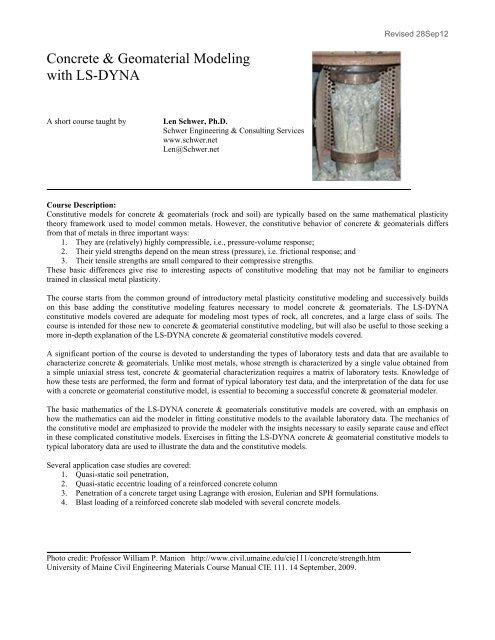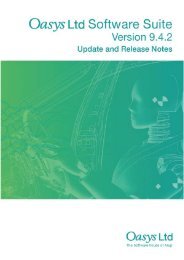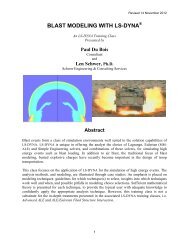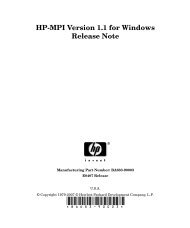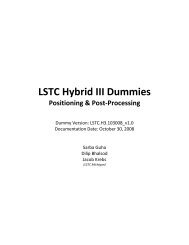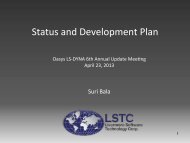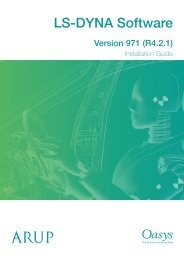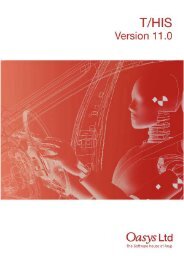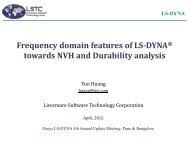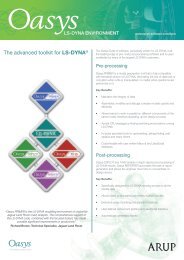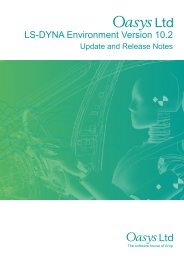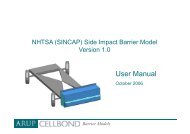Concrete & Geomaterial Modeling with LS-DYNA - Oasys Software
Concrete & Geomaterial Modeling with LS-DYNA - Oasys Software
Concrete & Geomaterial Modeling with LS-DYNA - Oasys Software
Create successful ePaper yourself
Turn your PDF publications into a flip-book with our unique Google optimized e-Paper software.
Revised 28Sep12<strong>Concrete</strong> & <strong>Geomaterial</strong> <strong>Modeling</strong><strong>with</strong> <strong>LS</strong>-<strong>DYNA</strong>A short course taught byLen Schwer, Ph.D.Schwer Engineering & Consulting Serviceswww.schwer.netLen@Schwer.net__________________________________________________________________________________________Course Description:Constitutive models for concrete & geomaterials (rock and soil) are typically based on the same mathematical plasticitytheory framework used to model common metals. However, the constitutive behavior of concrete & geomaterials differsfrom that of metals in three important ways:1. They are (relatively) highly compressible, i.e., pressure-volume response;2. Their yield strengths depend on the mean stress (pressure), i.e. frictional response; and3. Their tensile strengths are small compared to their compressive strengths.These basic differences give rise to interesting aspects of constitutive modeling that may not be familiar to engineerstrained in classical metal plasticity.The course starts from the common ground of introductory metal plasticity constitutive modeling and successively buildson this base adding the constitutive modeling features necessary to model concrete & geomaterials. The <strong>LS</strong>-<strong>DYNA</strong>constitutive models covered are adequate for modeling most types of rock, all concretes, and a large class of soils. Thecourse is intended for those new to concrete & geomaterial constitutive modeling, but will also be useful to those seeking amore in-depth explanation of the <strong>LS</strong>-<strong>DYNA</strong> concrete & geomaterial constitutive models covered.A significant portion of the course is devoted to understanding the types of laboratory tests and data that are available tocharacterize concrete & geomaterials. Unlike most metals, whose strength is characterized by a single value obtained froma simple uniaxial stress test, concrete & geomaterial characterization requires a matrix of laboratory tests. Knowledge ofhow these tests are performed, the form and format of typical laboratory test data, and the interpretation of the data for use<strong>with</strong> a concrete or geomaterial constitutive model, is essential to becoming a successful concrete & geomaterial modeler.The basic mathematics of the <strong>LS</strong>-<strong>DYNA</strong> concrete & geomaterials constitutive models are covered, <strong>with</strong> an emphasis onhow the mathematics can aid the modeler in fitting constitutive models to the available laboratory data. The mechanics ofthe constitutive model are emphasized to provide the modeler <strong>with</strong> the insights necessary to easily separate cause and effectin these complicated constitutive models. Exercises in fitting the <strong>LS</strong>-<strong>DYNA</strong> concrete & geomaterial constitutive models totypical laboratory data are used to illustrate the data and the constitutive models.Several application case studies are covered:1. Quasi-static soil penetration,2. Quasi-static eccentric loading of a reinforced concrete column3. Penetration of a concrete target using Lagrange <strong>with</strong> erosion, Eulerian and SPH formulations.4. Blast loading of a reinforced concrete slab modeled <strong>with</strong> several concrete models.__________________________________________________________________________________________Photo credit: Professor William P. Manion http://www.civil.umaine.edu/cie111/concrete/strength.htmUniversity of Maine Civil Engineering Materials Course Manual CIE 111. 14 September, 2009.
Revised 28Sep12Course Materials:The course notes consist of over 300 pages of descriptive text, presented in a narrative style, i.e. not a collection ofpresentation slides, arranged in more than 20 sections that include the exercises and their solution. Participants are offeredthe <strong>LS</strong>-<strong>DYNA</strong> input files for all examples, and Microsoft Excel workbooks containing the laboratory data for severalmaterials including a sandy soil, Salem limestone, and two concretes.Instructor:Len Schwer has worked on concrete & geomaterial applications, and developed constitutive models, for the past 25 years;he has been a <strong>DYNA</strong>3D user since 1983 and an <strong>LS</strong>-<strong>DYNA</strong> user since 1998. His early work at SRI International includedthe development of a Mohr-Coulomb constitutive model for modeling the rock surrounding tunnels under very highpressure loadings. While at Lockheed Missile and Space Company he worked on high speed earth penetrators designed topenetrate reinforced concrete structures buried in soil. In the early 1990’s, while working for APTEK, Inc., and as aconsultant, he co-developed <strong>with</strong> Yvonne Murray the Continuous Surface Cap Model for application in the UndergroundTechnology Program of the then-named Defense Nuclear Agency; this model is implemented in <strong>DYNA</strong>3D (Material Type37) and in <strong>LS</strong>-<strong>DYNA</strong> Version 970 (MAT145). From 1997 - 2001 he worked <strong>with</strong> Professors Belytschko and Liu ofNorthwestern University on applying their meshfree methods to reinforced concrete problems of interest to the DefenseThreat Reduction Agency. During 1999 - 2000 he contributed to a test and simulation program focused on non-standardloading of buried pipelines. From 1999 - 2002 he was a consultant to Sandia National Laboratories providingdocumentation, verification and validation for the constitutive models used by the Engineering & ManufacturingMechanics Group. He has a strong interest in verification and validation in computational solid mechanics, and is the recentpast Chair of the ASME Standards Committee on Verification and Validation in Computational Solid Mechanics.Len Schwer is a Fellow of the American Society of Mechanics Engineers (ASME) and the United States Association forComputational Mechanics (USACM).COURSE OUTLINE – Class starts at 9:00 AM and lectures end at about 4 PM. Additional time is allocated at theend of each day for one-on-one participant discussion <strong>with</strong> the instructor.Day 1Introduction to Metal PlasticityNomenclatureStress TensorPrincipal StressesStress InvariantsSpherical and Deviatoric Stress TensorsDeviatoric Stress Invariantsvon Mises Constitutive Model (Material Type 3)Uniaxial TensionThe Effective Stress or Mises StressPerfect Plasticity and HardeningOverview of a Numerical Constitutive Model AlgorithmDetermining the Plastic StrainThe Principle of Maximum Plastic ResistanceDrucker’s PostulateFlow Rule (a.k.a. Normality Rule)Consistency ConditionUpdating the StressTresca Yield CriterionDescription of the Pi-PlaneTwo Special Limiting Cases for the Lode AngleIntroduction to <strong>Geomaterial</strong>sCompressibility the Pressure – Volume ResponseMetals<strong>Geomaterial</strong>sPressure Enhanced Shear Strength – Frictional Materials
Revised 28Sep12Unconfined Compressive StrengthTri-Axial Compressive StrengthMohr CirclesMohr-Coulomb Failure CriteriaMohr-Coulomb Tri-Axial CompressionMohr-Coulomb Tri-Axial ExtensionSoil and Foam Model (Material Type 5)Shear Failure CriterionPressure-Volume SpecificationTwo Surface Model RepresentationOther Soil and Foam Model ParametersRelation to Drucker-Prager ModelAppendix: Engineering and True Stress-StrainMaterial Characterization - Laboratory Tests & DataHydrostatic Compression TestingTri-Axial Compression TestingUnconfined Compression TestingElastic Material Property DeterminationTypical Tri-Axial Compression Test DataOther Useful Material TestsUniaxial Strain Compression Test DataElastic Material Property DeterminationTri-Axial Extension TestMohr-Coulomb Failure Criteria in Tri-Axial ExtensionUsing the <strong>LS</strong>-<strong>DYNA</strong> Material Model DriverExercises - Calibrating the Soil & Foam constitutive model (MAT005) to low and high pressure soil data.Case Study - Quasi-static Soil Penetration.Day 2Pseudo-TENSOR (MAT016)Exercise - Using MAT016 (Response Mode I) to model limestone.Exercise - Using MAT016 (Response Mode II) to model concrete.Simple Input <strong>Concrete</strong> ModelsThe following single parameter (unconfined compression strength) models are compared <strong>with</strong> laboratorydata:*MAT_PSEUDO_TENSOR (Mode II <strong>Concrete</strong>)*MAT_CONCRETE_DAMAGE_REL3*MAT_WINFRITH_CONCRETE*MAT_CSCM_CONCRETE*MAT_RHT*MAT_CDPMCase Study – Reinforced <strong>Concrete</strong> Column Eccentric LoadingCase Study – <strong>Concrete</strong> Target Perforation using Lagrange <strong>with</strong> erosion, Eulerian & SPH Formulations.Case Study – Reinforced concrete slab under blast loadingIntroduction to the <strong>LS</strong>-<strong>DYNA</strong> Cap-Type Models for <strong>Geomaterial</strong>s:Geological Cap (MAT025 25)Demonstration. Calibrating the Geological Cap model (MAT025) to Salem Limestone laboratory data.
Revised 28Sep12Exercise 4. Calibrating the Geological Cap model (MAT025) to typical concrete laboratory data.Continuous Surface Cap Model (MAT145)Three Invariant FormulationStrain Rate EffectsKinematic Hardening of the Shear Failure SurfaceDamage <strong>Modeling</strong>Other <strong>LS</strong>-<strong>DYNA</strong> Material Models for <strong>Concrete</strong> & <strong>Geomaterial</strong>s (not covered):Soil and Foam Failure (Material Type 14)Orientated Crack (Material Type 17)Honeycomb (Material Type 26)Soil <strong>Concrete</strong> (Material Type 78)Hysteretic Soil (Material Type 79)Ramberg Osgood (Material Type 80)Brittle Damage (Material Type 96)Johnson Holmquist <strong>Concrete</strong> (Material Type 111)Modified Drucker Prager (Material Type 193)Soil Brick (Material Type 192)RC Shear Wall (Material Type 194)<strong>Concrete</strong> Beam (Material Type 195)Comments from Class Participants:“Really a great course and one I would highly recommend to others. I feel like I'm starting to understand my way aroundCAP models. I think your course material and explanation is the kind of instructive material that leads to better productivityand understanding.”“I really enjoyed your short course myself. This is because that this course not only cover the mathematical formulations ofthese geomaterial models, but also a lot of physical insights behind the various components in these models plus yourwealthy experiences of using them.”“I thought that it was very helpful in presenting the specific geomaterial data, but I also appreciated the background insimple plasticity because I have a fluid mechanics and heat transfer background.”Useful Reference Books:Soil Plasticity: Theory & Implementation, Developments in Geotechnical Engineering Series #38Authors: Chen, Wai-Fah and Baladi, G. Y.Elsevier Science, December 1985, Hardcover, 234 PagesISBN: 0444424555Nonlinear Analysis in Soil Mechanics: Theory & Implementation, Developments in Geotechnical Engineering Series #53Authors: Chen, Wai-Fah and Mizuno, E.Elsevier Science, December 1990, Hardcover, 672 PagesISBN: 0444430431Experimental Soil MechanicsAuthor: Bardet, Jean-PierrePrentice Hall, July 1996, Hardcover, 583 PagesISBN: 0133749355Reinforced <strong>Concrete</strong> Design
Revised 28Sep12Authors: Chu-Kia Wang and Charles G. SalmonHarper Colins PublishersISBN: 0-06-046887-4Soil Behaviour and Critical State Soil MechanicsAuthor: David Muir WoodCambridge University Press, January 1990, 462 pagesISBN: 0521337828Finite Element Analysis in Geotechnical Engineering: ApplicationAuthors: David M. Potts and Lidija ZdravkovicThomas Telford, August 2001, Hardcover, 427 PagesISBN: 0727727834Finite Element Analysis in Geotechnical Engineering: TheoryAuthors: David M. Potts and Lidija ZdravkovicThomas Telford, 1999, Hardcover, 440 PagesISBN: 0727727532CEB-FIP Model Code 1990: Design CodeAmerican Society of Civil Engineers, August 1993, Hardcover, 437 PagesISBN: 0727716964Computational InelasticityAuthors: Juan C. Simo and Thomas J. HughesPublication Date: December 1997ISBN: 0387975209Nonlinear Finite Elements for Continua and StructuresAuthors: Ted Belytschko, Wing Kam Liu, & Brian MoranPublication Date: June 2000ISBN: 0471987735


